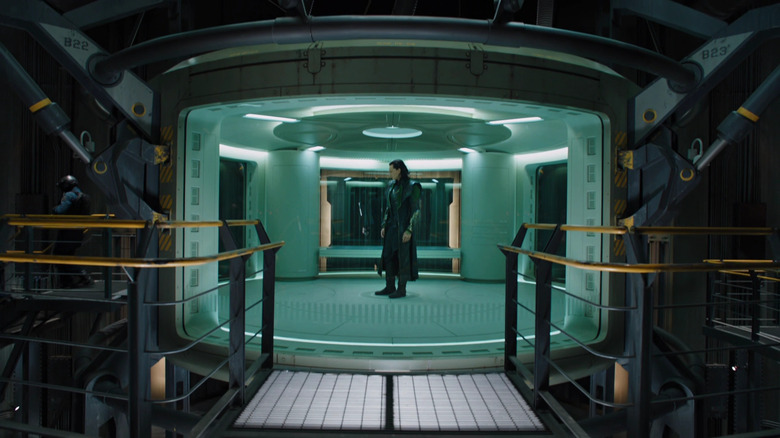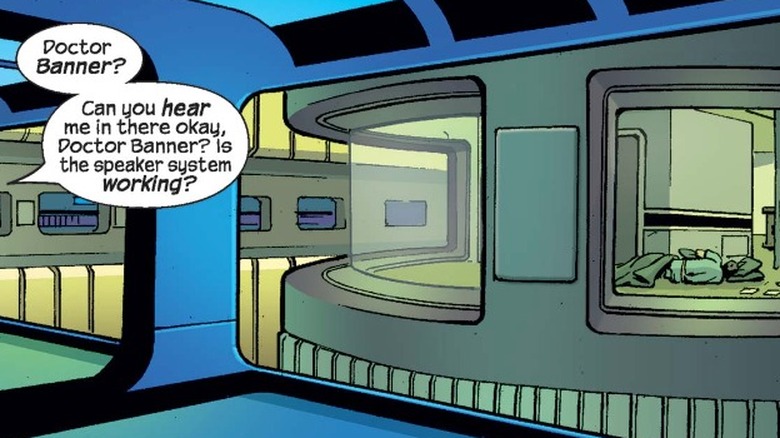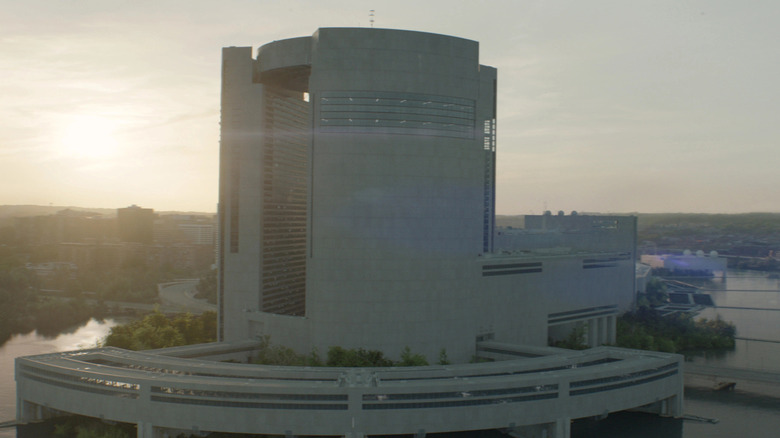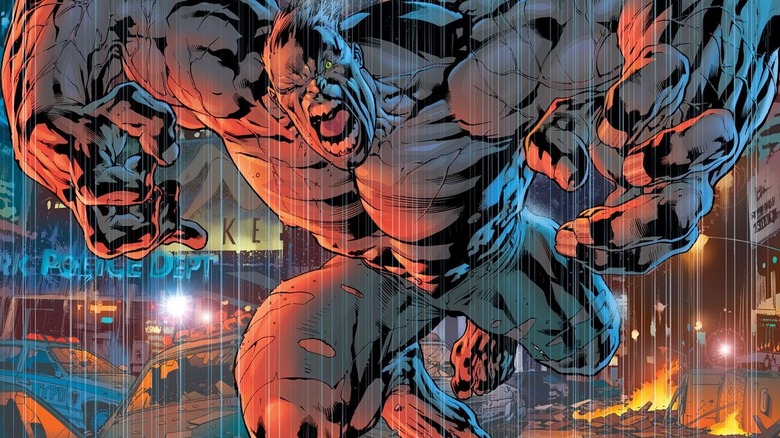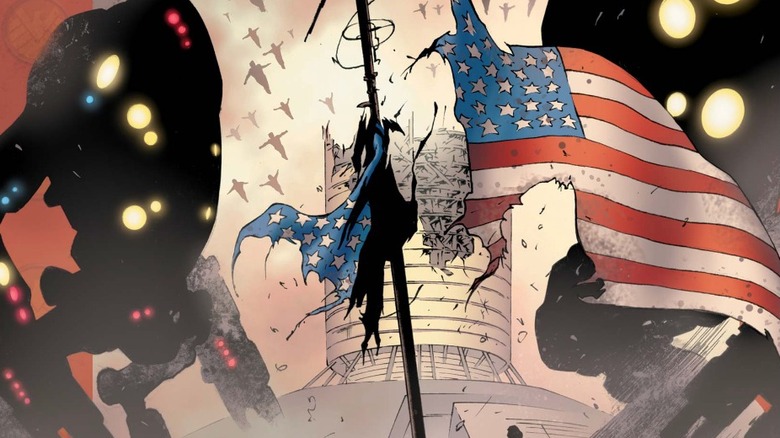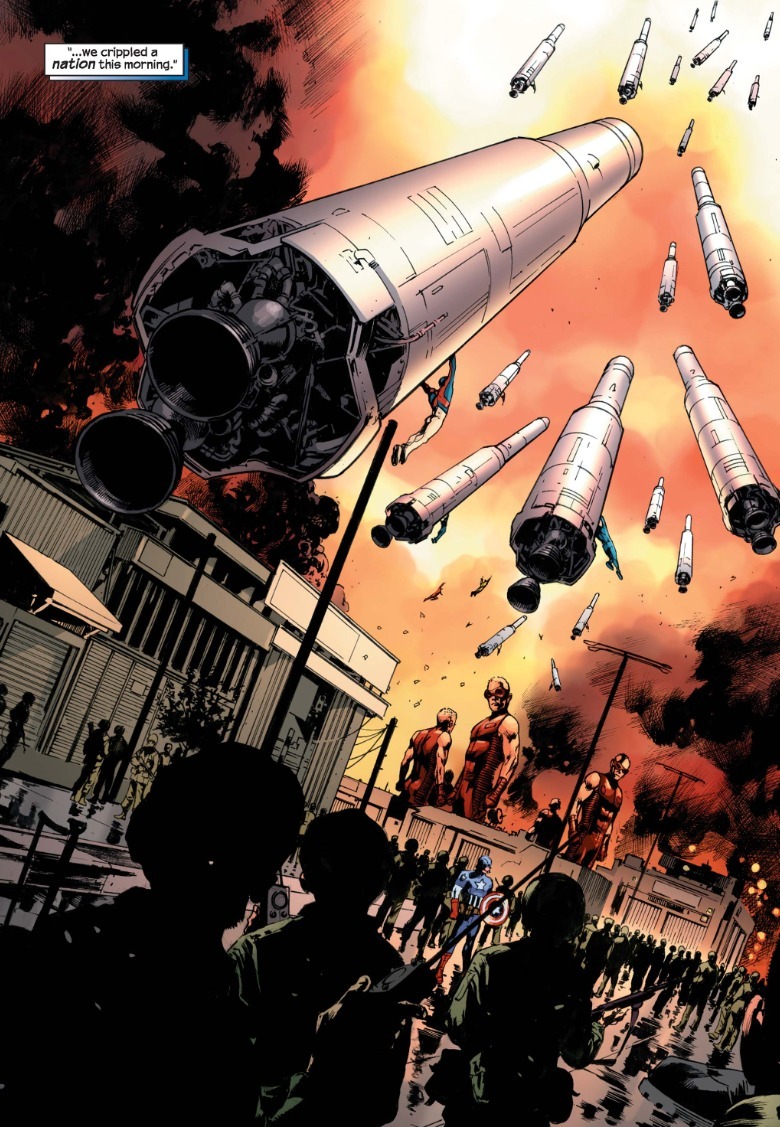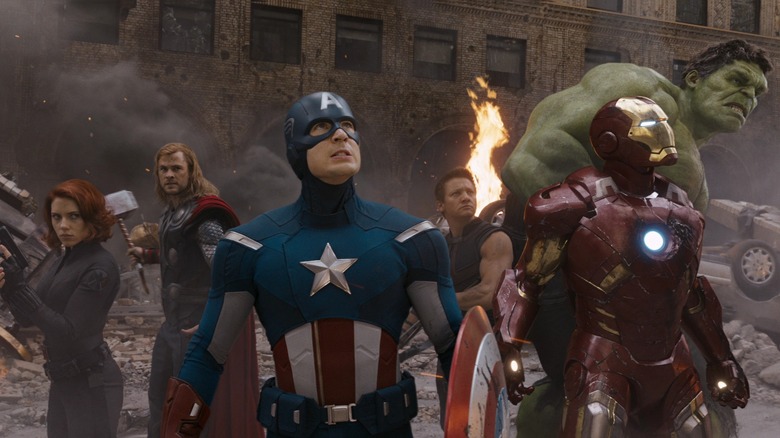Loki's Hulk-Proof Helicarrier Cell In Marvel's Avengers Actually Comes From Another SHIELD Location
2012's "The Avengers" is a blockbuster inflection point, ending the brief reign of grim-and-gritty pop movies kicked off by 2008's "The Dark Knight." After Earth's Mightiest Heroes roused audiences at the box office, Hollywood started chasing cinematic universes, not Nolan-izations. Yet, funnily enough, "The Avengers" itself uses a blockbuster trope often credited to "The Dark Knight" — the villain who purposefully gets captured in the middle of the movie.
"The Avengers" writer/director Joss Whedon understood the key to making a successful movie was to place these six conflicting personalities into a single space and let the tensions boil. That's why the bulk of "The Avengers" unfolds on SHIELD's helicarrier; Whedon himself invoked "Glengarry Glen Ross" when describing his approach.
Having big bad Loki (Tom Hiddleston) be captured and kept in a cell on the helicarrier keeps him in focus, placing him close to the conflict even when the movie is simmering down and doesn't need an external threat. One of Loki's earliest attempts at weakening his enemies' trust in each other is him giving voice to what they all know; his circular and transparent cell (which drops from the Helicarrier if the subject tries to escape) was built to contain a different "monster": The Hulk.
According to "The Avengers: The Art of the Movie" by Jason Surrell, production designer James Chinlund nicked the design of Loki's cell from Mark Millar and Bryan Hitch's "The Ultimates." Specifically, the subplot where Bruce Banner is imprisoned in such a cell several layers beneath SHIELD's headquarters, the Triskelion.
Designing Loki's cell in Marvel's The Avengers
When interviewed for Surrell's book, Chinlund recalls being taken with Hitch's art of the Hulk cell in "The Ultimates." He was convinced it was an innately cinematic design (and one fans would appreciate seeing recreated on film). So, he and his team incorporated it in a way that also showed off the "grit and texture" of the helicarrier itself:
"The glass pod allowed us to create a much more dynamic space than your typical cell, and the threat of ejection created a constant tension. It was a great example of the dynamics of the set becoming a character in the film."
Indeed, Loki eventually breaks out of the cell and traps his avenging brother Thor (Chris Hemsworth) in it. (Incidentally, Thor also spends some time in the Triskelion cell in "Ultimates 2," but let's save that story for later.) When Thor tries to smash his way out of the cell with his hammer, it ejects from the helicarrier. It also leaves him unable to do anything as he watches Loki kill his mortal friend, SHIELD Agent Phil Coulson (Clark Gregg).
The scenes where Avengers talk to the imprisoned Loki evoke Hannibal Lecter (Anthony Hopkins) in "The Silence of the Lambs." Now, no can or should ever compare Whedon's barely-there direction to Demme's masterful framing of every Hannibal/Clarice Starling (Jodie Foster) conversation. Still, Chinlund thinks the cell design added atmosphere that a barred cage wouldn't have. "We were excited about the idea that the pod was a lamp — glowing in the darkness, creating opportunities for silhouettes and multiple reflections," he said.
The influence of The Ultimates on the Marvel Cinematic Universe
The Triskelion is an invention of "The Ultimates" — which, for context, was part of the 2000s "Ultimate Marvel" reboot that updated Marvel's classic heroes for the 21st century. In "The Ultimates," the Triskelion (located in Manhattan) is SHIELD's permanent base; the organization has a whole fleet of helicarriers, not just one that acts as a mobile headquarter.
The MCU Triskelion eventually showed up in 2014's "Captain America: The Winter Soldier," but it was moved to Washington DC, sitting on the Potomac River instead of the Hudson. (Honestly, a U.S. intelligence agency base like that probably would be located in DC, not NYC, in real life.)
The influence of "The Ultimates" on "The Avengers" and the Marvel Cinematic Universe as a whole ends nowhere near here. Whedon wrote a glowing introduction in the comic's first volume (in 2004, long before he was ever considered to make "The Avengers," I might add). Whedon points out that the Avengers have never been a harmonious whole like the Fantastic Four or X-Men, but a bunch of stragglers thrown together at random. He describes the thesis of "The Ultimates" as such, and it's one that carries over into his movie: "These people are together because the world needs saving. And this flawed, bizarre group of mismatched myths is the only team in the world that can save it and watching them do it is a glorious thing."
The fact that the Ultimates don't belong together is integral to why both the Hulk and Thor spend time locked up.
The Hulk in The Ultimates inspired the MCU
In the Ultimate Marvel universe, Bruce Banner didn't become the Hulk because he was exposed to a "Gamma Bomb" blast. Rather, he was trying to recreate the super soldier serum that made Steve Rogers into Captain America. When he tested it on himself, cue the Jolly Green Giant. (The MCU aped this origin for the Hulk too, but didn't spend much time on it.)
Banner's initial Hulk episode is a one-off; the serum gradually dissipates from his body and that's that. That is, until Nick Fury hires him to restart the project, hoping to get some super soldiers on his new superhero team. Once SHIELD finds the frozen Captain America, Banner's scientific job becomes redundant. None of his colleagues particularly like Banner and he's constantly emasculated by Betty Ross, his ex-girlfriend and the Ultimates' PR flack. So, in issue #4, he takes a new Hulk serum, telling himself he can help his "friends" by giving them a villain to fight. As he admits, the real reason he did it is because he "missed being big." Cue the Hulk transforming in the middle of Manhattan, tearing through the city and killing 800+ people. This time, the Hulk serum bonds to Banner's cells; since he can transform any time he gets angry, SHIELD pumps him full of sedatives and locks him in the Triskelion.
The playful, kindhearted (but admittedly "always angry") Bruce Banner played by Mark Ruffalo in the MCU couldn't be further from the one in "The Ultimates." That Bruce is pretty much an incel, down to violently exploding in public, and the anger boiling beneath his skin is shown in a much creepier light. (Though, in some less enlightened writing, Millar also portrays Betty as being a lot more turned on by Bruce once he "mans up" as the Hulk; she even requests a conjugal visit in the Hulk's glass cell.)
Why The Ultimates is a lot darker than The Avengers
"The Ultimates" is a satire, which "The Avengers" definitely isn't. The team's formation is portrayed as, essentially, another waste of taxpayer money like so many other extravagant military expenses are. (In a more sinister light, the book shows that the public-facing Ultimates are just mascots while trained SHIELD spooks like Black Widow and Hawkeye take care of the real work.) That the Ultimates only get a super-villain to fight from within their own ranks is putting a point on how America creates problems to justify its own interventions.
This point gets watered down in the second half of "The Ultimates," where a genuine alien invasion happens (the Chitauri, a name Whedon appropriated for the aliens in his "Avengers"). So, the Ultimates need to rally, including letting Hulk loose on the invaders. Once that threat is passed, Bruce goes right back in the cell.
The politics come roaring back in "Ultimates 2," though (published from late 2004 to 2007). The first issue ends with Banner being publicly exposed as the Hulk, so he's put on trial (remotely) and sentenced to death via nuclear bomb (it doesn't take). His cell doesn't stay empty, though. Thor (who, in the Ultimate Universe, is a progressive champion out to "save the world" by leading environmental protests) resigns from the Ultimates because he's convinced SHIELD will use the team to spearhead U.S. invasions of Iran and Syria. So, Fury organizes a strike force to take down Thor, throws him in Banner's old cell, and then sends the Ultimates to the Middle East once the God of Thunder is out of the way.
What the MCU is missing from The Ultimates
Yeah, the Ultimates are kind of bastards, aren't they? They're honestly closer to The Boys than The Avengers.
"The Avengers" still has the Ultimates assembled by SHIELD, but the movie doesn't broach the political implications of superheroes being a tool of the U.S. armed forces. The closest the MCU has come to dealing with this is the aforementioned "Winter Soldier" (where Captain America realizes SHIELD is a piece of a corrupt system) and Whedon's sequel "Age of Ultron" (where the Avengers are allegorized as representing U.S. interventionism, but much less loudly than how Millar and Hitch did so).
Granted, by the time "The Avengers" hit theaters, Bush and Cheney had (thankfully) been out of office for years. Their policies, though, were not so easily erased. The portrayal of America in "The Ultimates" as an empire always looking for new ways to hold onto its power is one that holds up even as the book is unmistakably a product of the 2000s. I don't think anyone expects superhero blockbusters to be their main source of political satire, but it would be refreshing for the MCU to look beyond the surface-level details of the comics it adapts.
